|
|
The pinakes are one of the highest and finest
artistic examples that the ancient culture of Magna Graecia has handed down and their
importance is such that archaeologist Paolo Orsi himself, speaking of them, stated that: "It only takes the
famous pinakes, endless source of research for scholars of religion and cults, to bring joy
to the artists and mark the glory of a museum".
|
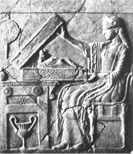 |
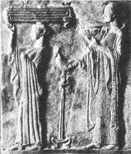 |
PERSEPHONE OPENS THE MYSTIC BASKET
(Image source: G. Incorpora -
Locri Antica e Gerace,
Ponte Nuovo Editrice, Bologna 1980 - II Edizione
- pag. 47) |
TROUSSEAU OFFERING
(Image source: G. Incorpora -
Locri Antica e Gerace,
Ponte Nuovo Editrice, Bologna 1980 - II Edizione
- pag. 47) |
Unearthed in fragments (it was a ritual custom to break them)
inside large votive deposits brought back to light during excavations at the Sanctuary of Mannella
(the modern name of the place on whose slopes rise the
Sanctuary ruins), the pinakes are terracotta relief plaques which date back to a period
that ranges from 490 b.C. to 450 b.C.
|
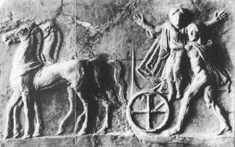 |
THE ABDUCTION OF PERSEPHONE
(Image source: L. Costamagna e C. Sabbione
- Una cittÓ in Magna Grecia Locri Epizefiri,
Laruffa Editore, Reggio Calabria 1990 fig. 62) |
Since the
pinakes are tied to the worship rituals that took place at the Sanctuary,
known all over the Greek world as Persephoneion, it is not surprising that most of them represent
scenes from the myth of Persephone, although there are examples in which are represented also other deities,
such as Aphrodite. |
|
MYTHOLOGY
Persephone is the daughter of
Zeus and Demeter.
Hades felt in love with her and, during an absence of
Demeter, he kidnapped her while she was picking up
some flowers nearby Pergus lake, and took her to the
Avernus.
Demeter
desperately searched for her everywhere
until, thanks to Helios, she
discovered the name of the
abductor.
Then, angry, she spoke to
Zeus to get her
daughter back but, since Persephone,
by eating some pomegranate grains, had broken the fasting
which would have allowed her to go back to the Earth,
her request wasn't complied.
Therefore Demeter,
goddess of the harvest, threatened to make the
earth unfruitful and Zeus, worried
about the situation, made possible an agreement by which
Persephone had to
remain for six months (autumn and winter)in the
Avernus and for six months (spring and summer) with
her mother. (According to a different version of the
myth: for a third of the year with
Hades and for
two third with Demeter).
Since her abduction
Persephone became the goddess of
hell, also
called by the Greek Kore (hence the name of the feasts
dedicated to her and called Koreies).
The Romans called her Proserpine. |
|
|
|
|
|
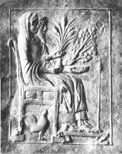 |
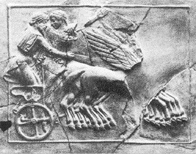 |
PERSEPHONE AND HADES ON THE THRONE
(Image source: G. Incorpora -
Locri Antica e Gerace,
Ponte Nuovo Editrice, Bologna 1980 - II Edizione
- pag. 47) |
THE ABDUCTION OF PERSEPHONE (other representation)
(Image source: Prof. G. Incorpora's private archive) |
Due to the large number of pinakes
unearthed during the excavations and their
often poor conditions, so far their classification
isn't complete.
Nowadays the greatest part of the pinakes can be admired at
the National Museum of Reggio Calabria, while some of them
are exposed at the National Archaeological Museum Of Locri Epizephyrii. |
|

